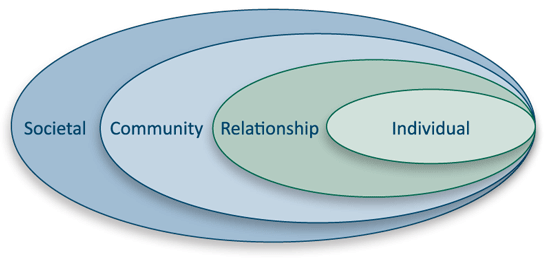Prevention
Working to Prevent Sexual and Domestic Violence Before It Begins
Sexual and domestic violence are preventable social and health problems that have lasting effects for people, families, communities, and society as a whole. Primary prevention strategies work to decrease the incidence of first-time perpetration of violence and victimization. These strategies are achieved by changing social norms, policies, and conditions at the individual, relationship, community, and societal levels, or at all levels of the social ecology.
Kansas Comprehensive Plan to Prevent Sexual and Domestic Violence, 2019 - 2024
In 2011, The Kansas Coalition Against Sexual and Domestic Violence, the Kansas Department of Health and Environment (KDHE), and the Kansas Sexual and Domestic Violence Primary Prevention Advisory Committee presented Reweaving Our Social Fabric: A Plan for the Primary Prevention of Sexual and Domestic Violence in Kansas.
In March of 2019, the Kansas Sexual and Domestic Violence Primary Prevention Advisory Committee was called together to review progress made since 2011 and update the State Plan. We are pleased to provide this updated Reweaving the Social Fabric: A Plan for the Primary Prevention of Sexual and Domestic Violence in Kansas, 2019-2024.
How Prevention Works
Prevention strategies work in conjunction with intervention strategies. Crisis intervention and safe services are essential for helping victims of sexual and domestic violence, whereas prevention works to change social norms to prevent perpetration from ever occurring. Prevention strategies include teaching skills for developing healthy, respectful, and nonviolent relationships. This includes the promotion of mutual respect, anti-bullying, and bystander intervention messages and skills. Prevention efforts include reducing known risk factors for perpetration of sexual and domestic violence and promoting protective factors.
Risk and Protective Factors
Certain risk factors are associated with a greater likelihood of sexual or domestic violence perpetration. A combination of individual, relational, community, and societal factors can contribute to the risk of becoming a perpetrator or victim of sexual or domestic violence. They are contributing factors and may or may not be direct causes. Understanding risk and protective factors can help identify various opportunities for prevention.
Not everyone who is identified as “at risk” becomes involved in violence. Although risk factors may be prevalent, when taken alone, they do not predict perpetration. They should be seen as contributing to the likelihood of perpetration, but not causative. Protective factors are factors that minimize the likelihood of being victimized by sexual or domestic violence (CDC 2012).
Risk Factors for Sexual and Domestic Violence
Individual Risk Factors
- Being a victim of physical or psychological abuse
- Prior history of being physically abusive
- Belief in strict gender roles (e.g., male dominance, aggression in relationships)
- Desire for power and control in relationships
- Perpetrating psychological aggression
Relationship Factors
- Dominance and control of the relationship by one partner over the other
- Unhealthy family relationships and interactions
Community Factors
- Weak community sanctions against sexual and domestic violence (e.g., unwillingness of others to intervene in situations where they witness violence)
- Poverty and associated factors
- Lack of institutions, relationships, and norms that shape healthy community social interactions
Societal Factors
- Traditional gender roles (e.g., women should stay at home, not enter workforce, be submissive; men as superior to women, support the family, make decisions)
- High tolerance for levels of crime and other forms of violence
(CDC, 2009)
Primary Prevention Resources
Centers for Disease Control and Prevention
www.cdc.gov/ViolencePrevention
Prevent Connect
www.preventconnect.org
Kansas Department of Health and Environment, Sexual Violence Prevention and Education Program
www.kdheks.gov/rpe
KANSAS CRISIS HOTLINE: 888-END-ABUSE | 888-363-2287

